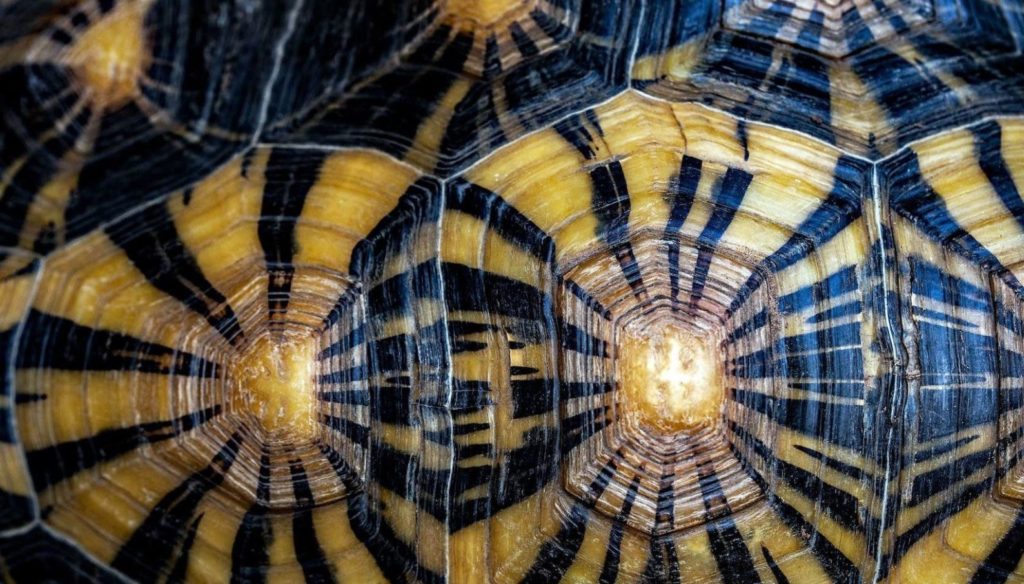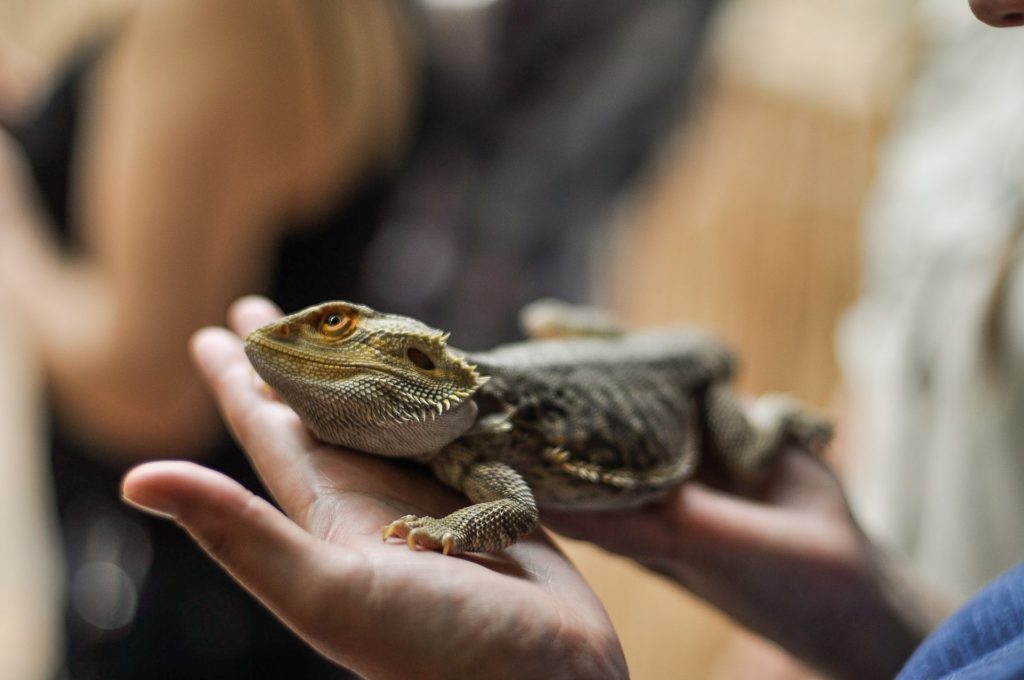
If your child is into reptiles and wants one for themselves, you might have wondered which are the best reptile pets for kids.
Reptiles can be amazing pets, especially for those children that want an animal friend but are allergic to fur or feathers!
They are less time-consuming compared to dogs, for example, make less noise, eat less, occupy less space, so taking care of one can be a perfect option for your busy little one.
Additionally, kids will develop responsibility, empathy and will learn to respect nature’s creatures, while playing with their cold-blooded friends.
In this post, we present you 7 good reptile pets for kids, that any child will be thrilled to have.
Here you’ll find:
What Is The Best Reptile Pet For A Child? The Leopard Gecko!
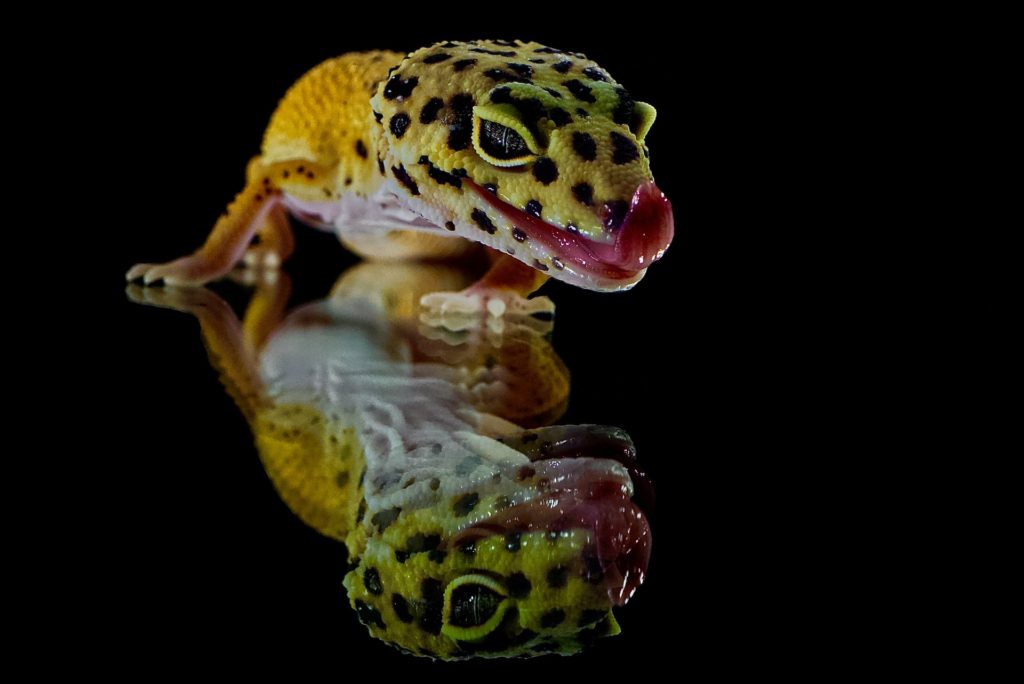
Leopard geckos are easy to take care of since their living requirements are very basic.
With their docile nature, the fact that they eat insects (especially crickets), and their long lifespan (10-15 years in captivity), leopard geckos are the best reptile pet for children to have.
Additionally, if you pick a common leopard gecko, you would be paying around $30-$75, which places this cutie among the cheap pets for kids.
7 Best Reptile Pets For Kids
Now let’s dig into the full list of reptile pets for kids, so you and your little one can have an idea of what to pick.
1. Leopard Geckos
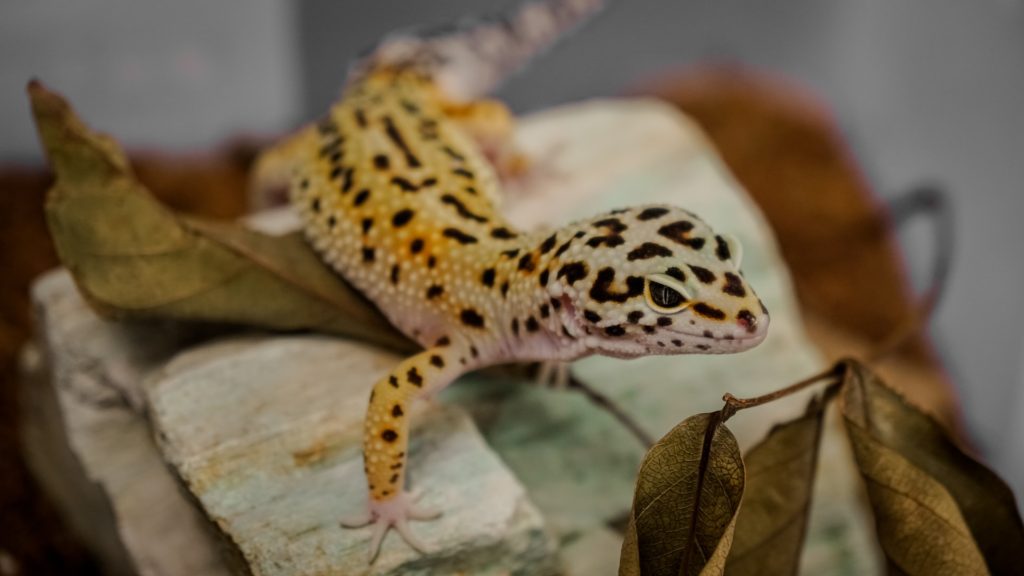
| Average Size (adults) | 18 cm – 28 cm (7.1 in to 11.0 in) |
| Average Weight | 50 – 80 grams |
| Average Lifespan | 10-15 years |
| Diet | Small invertebrates |
| Cost | $30 – $3000 |
As we just mentioned, leopard geckos are our pick as the best reptile pet for a kid.
Behavior
They are generally docile, if they bite you or your child, it will probably feel more like pressure on the skin than a painful injury.
Additionally, they are more active during the night.
Leopard geckos voluntarily lose their tail—a process called caudal autotomy—if they are attacked or held by it, which is a great defense mechanism against predators.
The tail will twitch for a couple of minutes, which will allow the gecko to escape while the potential predator is lured to the moving tail.
The tail regenerates again, but its appearance will never be the same as the original tail.
They are easy to take care of, but children must handle them carefully to minimize the chance of losing the tail.
Also, their toes lack sticky toe pads, so there’s no need to worry about your leopard gecko climbing vertical surfaces (aka, your walls).
Appearance And Price
Leo geckos have a vast variety of morphs (selectively bred to display certain colors, patterns, or sizes), so your child will be able to pick their favorite.
Of course, the morphs vary in price, so keep one eye on that if you’re on a budget.
For example, the more economic morphs can cost up to 30 dollars, while the expensive can go up to 3,000!
Food And Living Requirements
Leo’s diet includes small insects and invertebrates (and occasionally small vertebrates, such as pinky mice).
You can give them supplements for reptiles, by powdering and dusting them all over their yummy insects.
This will keep them healthy and reduce the risk of developing a disease captivity-related, such as Metabolic Bone Disease.
The tank where you’ll keep them should be spot-cleaned from feces and food residues and should contain rocks and plants for them to climb.
Even if they’re nocturnal, indoors leopard geckos benefit from UV-A/UV-B bulbs and an over-the-tank heat bulb, to synthesize vitamin D, and keep their body temperature on point, respectively.
Try to place a shallow bowl of water as well, to help them keep their skin moisturized, which is important for normal skin shedding.
They can live 10-15 years in captivity, so they can potentially accompany your child for a long time.
What we love:
- Very easy to take care of
- Docile
- Large lifespan
- Large morph and price range
- They cannot climb walls
What gives us pause
- They need to be handled carefully
2. Bearded Dragon Lizards Are The Best Large Reptile Pet For Kids
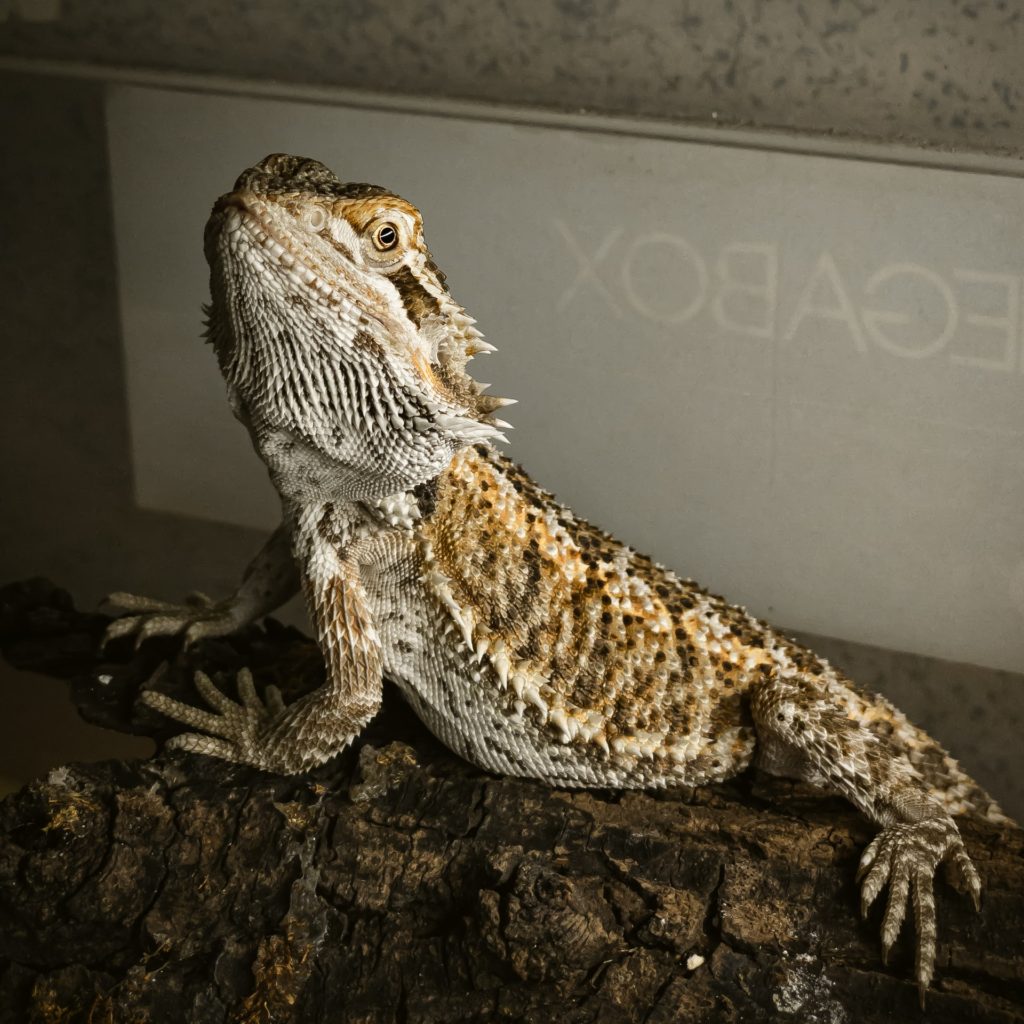
| Average Size (adults) | 51 cm – 60 cm (20 in to 24 in) |
| Average Weight | 300 – 600 grams |
| Average Lifespan | 10-20 years |
| Diet | Omnivorous |
| Cost | $60-$400 |
Bearded dragons are among the most low-maintenance reptile pets out there, and we can see why!
They certainly deserve a spot among the best reptile pets for kids.
Behavior
They are docile with humans, but adult males are quite territorial in the presence of other males, and sometimes, females.
If beardies perceive a threat or are stressed, they will display their beard, which also darkens.
Appearance And Price
They are relatively large lizards, with triangle-shaped heads, and their sturdy body allows them to better resist the handling of their young owners.
The common sandy morph is around $60, but there are several morphs that are more expensive.
Their skin is covered with spiny scales that are more conspicuous in the underside of the throat, hence the name “bearded dragon”.
Food And Living Requirements
Beardies are very easy to take care of!
You’ll only need to set up a large glass tank with an appropriate light heating system, as well as UV-B / UV-A bulbs, some branches for them to climb, a shallow bowl of water, so they can refresh if they’re up to it, and they’re ready to go.
There are different substrates you can use, such as reptile carpets, wood chips, and others.
Beardies are omnivorous, meaning they eat a wide variety of things, and they are quite voracious.
Baby and young bearded dragons eat insects frequently, whereas adult specimens eat plants, especially leafy greens, in addition to insects.
Young ones shouldn’t be fed with pieces of food (especially insects) that are too big for them (bigger than the space between their eyes are a no-no), and adult ones shouldn’t eat oversized insects either.
They prefer live prey, including crickets and meal worms. Feed them chopped veggies, such as spring greens, kale, spinach, bell peppers, among others.
You’ll need to give them some supplements (previously checked with your vet, of course) of vitamin D, multivitamin, and Calcium. Powder and sprinkle the supplement all over their food.
Even if their care requirements are not complicated, it’s important to feed them properly and provide them enough heat and light to allow vitamin D synthesis (which happens in their skin).
This will help your beardie to avoid fatal diseases such as Metabolic Bone Disease, upper respiratory infections, among others.
These gorgeous animals can live up to 20 years in captivity, so with proper care, they can be your kid’s pet for a long time.
What we love:
- Very docile and charismatic
- Easy to take care of
- Sturdy and handling resistant
- Large lifespan
- Low maintenance
What gives us pause:
- Their food size need to be watched carefully
3. Corn Snakes
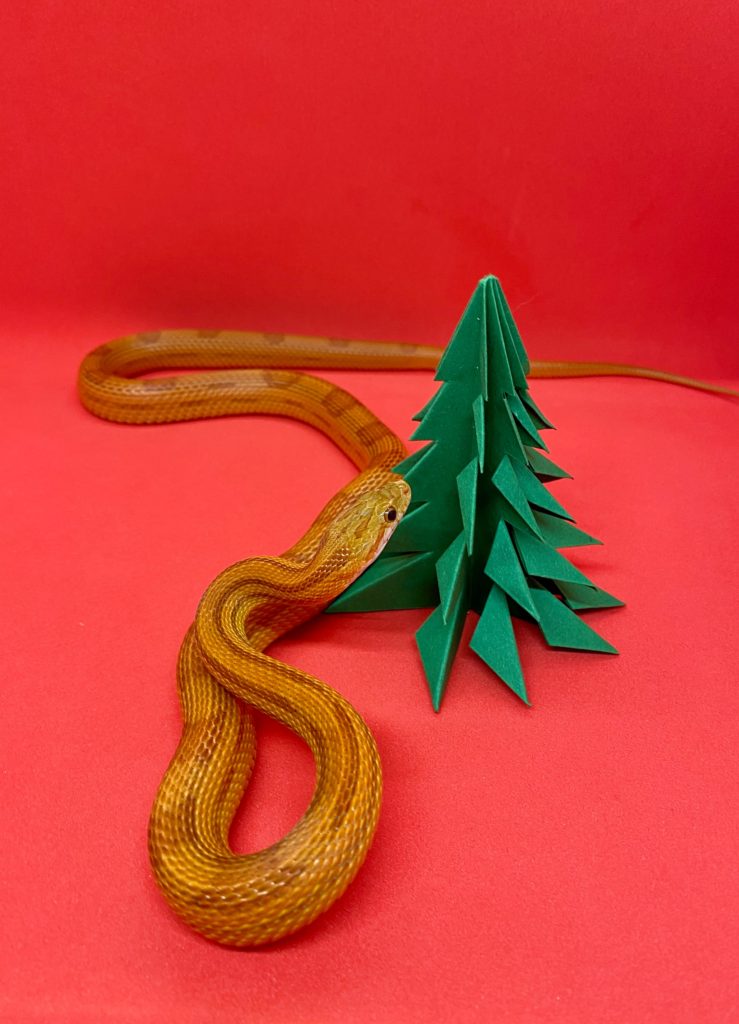
| Average Size (adults) | 61 cm – 182 cm (2.00 ft to 5.97 ft) |
| Average Weight | 500 – 900 grams |
| Average Lifespan | 15 – 20 years |
| Diet | Mainly rodents, but also reptiles, amphibians, and bird eggs |
| Cost | $20-$50 |
If your child is more into snakes, then a great option for them is corn snakes.
Behavior
Needless to say, these snakes are non-venomous, and they kill their prey by constriction, meaning they squeeze them to death.
Ouch.
They are quite social and active, so your kids will find them entertaining.
Appearance And Price
Their beautiful color patterns and morphs make them super appealing, and because their size is around 61–182 cm (2.00–5.97 ft), children can safely manipulate them.
The more common morphs are also cheap, costing between $20-$50.
Food And Living Requirements
They are among the best reptiles for beginners, since they can live for a long time (15-20 years) and their care requirements are very basic.
Although they are known to consume reptiles, amphibians, and bird eggs, their favorite treat for sure is mice and other small rodents.
So make sure to educate your child about this, because they’ll need to feed newborn mice if the snake is young, and adult mice if the snake is older.
Feeding them once every 7 days will work fine.
The substrate should be changed once every one or two months, and make sure their container is securely locked because these snakes are known for their abilities to easily escape.
What we love:
- Docile
- Social
- Easy to manipulate
- Large lifespan
- Many morphs
- Cheap
What gives us pause
- They can escape easily
4. Russian Tortoise
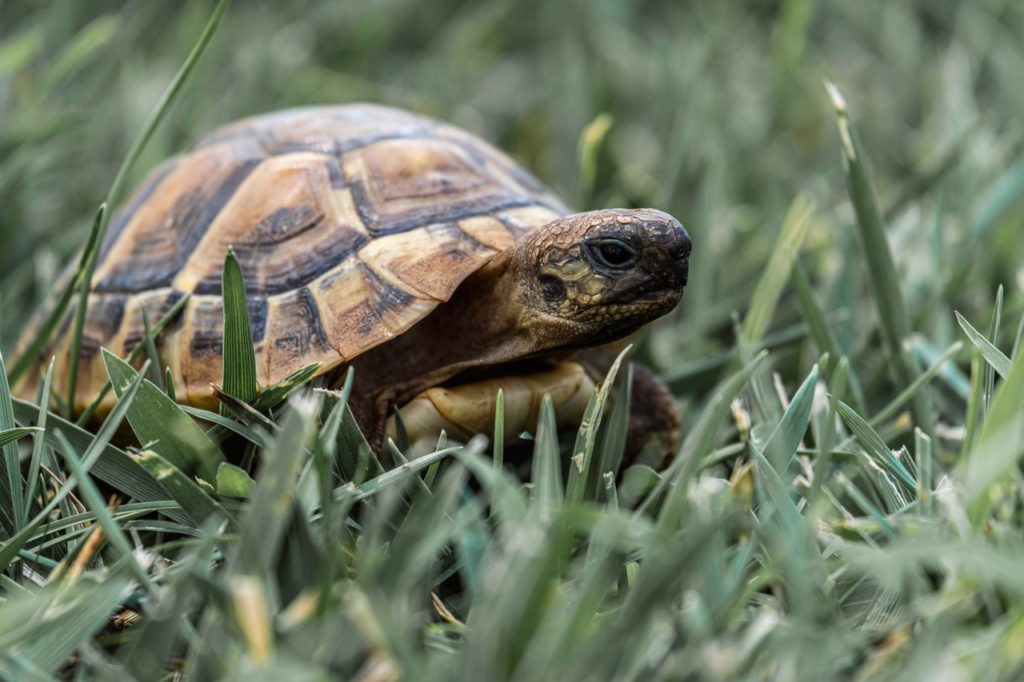
| Average Size (adults) | 13 cm – 25 cm (5 in to 10 in) |
| Average Weight | 300 – 1500 grams |
| Average Lifespan | 40-50 years |
| Diet | Herbivores (eat plants) |
| Cost | $100 – $200 |
If your child likes turtles, consider giving them a Russian tortoise, one of the best turtle pets for kids.
Behavior
These are quiet and slow-moving animals that are very active, which makes them a perfect companion for an equally active kid!
They are very charismatic, recognize their owners, and oh boy, do they LOVE to eat! Get your child ready to feed them a lot.
If you have a backyard, your child can safely play with their pet outside, as long as the temperatures are warm.
They love to dig and burrow, so their tank should have a deep substrate (more on this below).
Their lovely personality and easy care make them one of the best first pets for kids.
Appearance And Price
They remain small, though females tend to be a little larger than males, and the carapace is rounded and brown.
These turtles cost between $100 and $200, but they’re definitely worth the price.
Food And Living Requirements
Their enclosure could be a cage or a glass tank and kept well ventilated. Remember to use heat and UV-B bulbs to provide heat and allow them to synthesize vitamin D.
If you live in a warmer place and have a backyard or balcony, let your tortoise bask in the sun, but make sure they can hide if they want to.
You don’t want your turtle to overheat.
The substrate in the tank/cage should be deep enough that the tortoise can dig, and if it’s made out of digestible components such as rabbit or alfalfa pellets, you’ll have to change it often to prevent mold growth.
Our shelled friends are herbivores, they should be fed with plants, such as dark leafy greens, lettuce, carrots, grass, and occasionally small portions of fruits such as apples and pears.
Since their natural habitat is deserted and arid places, these animals usually take their water from the food they consume.
Nevertheless, water is still important for every creature, so place a shallow plate of it for the tortoise to drink or soak whenever it wants.
Keep the tank free of wasted food and their water plate clean.
They can live between 40 and 50 years, so your kids will have a pet even when they are adults!
How awesome!
What we love:
- Very active, charismatic, and responsive
- Easy to take care of
- Long lifespan
- Perfect size
What gives us pause:
- They eat a LOT
5. Blue-Tongued Skink
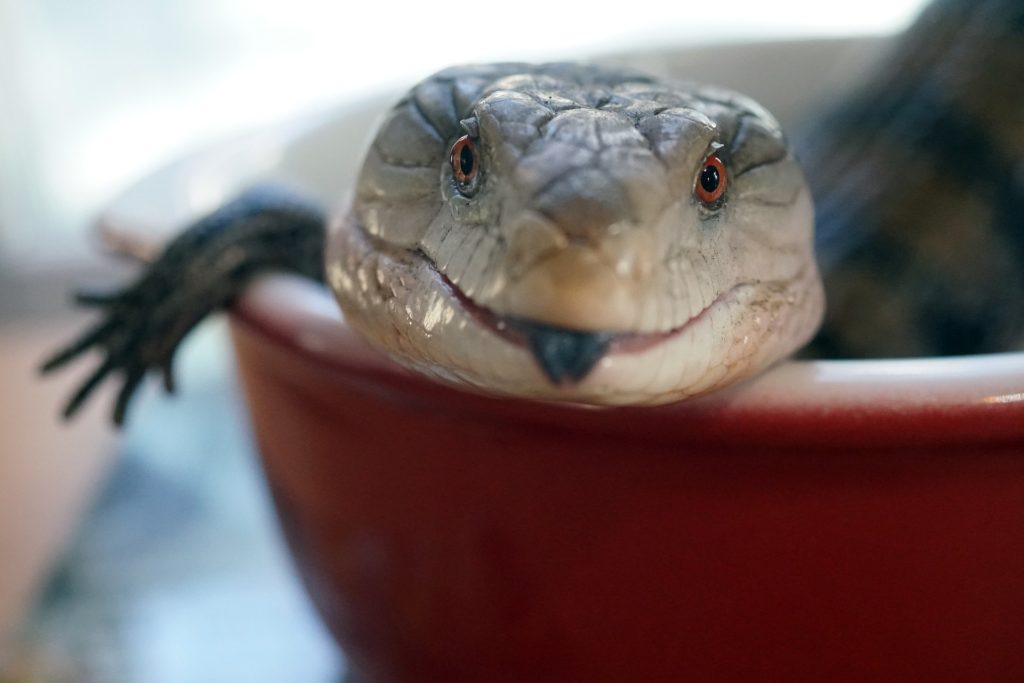
| Average Size (adults) | Up to 61 cm (up to 24 in) |
| Average Weight | 280 – 510 grams |
| Average Lifespan | 10-20 years |
| Diet | Omnivores |
| Cost | $150 – $5000 |
One of the best lizard pets for kids out there is the native-to-Australia blue-tongued skink, but we recommend it especially for older kids that can manipulate them with more care.
Behavior
The reason we recommend this lizard as a pet for older children is that, even if they are generally docile and easy to handle, these guys are large and can bite (painfully) when they feel threatened.
Or hiss and stick out their blue tongue at you.
So an older kid will be able to treat them with more care and will be less prone to startle them.
They are ground dwellers, so they won’t need branches in their tank. You can also take them out to your backyard and let them wander and feed on snails and wildflowers.
Appearance And Price
That being said, these are gorgeous and interesting reptiles, with short legs and an elongated body that reminds us of a snake.
They have a distinctive blue tongue after which they are named, and have a large size (up to 61 cm, or 24 in).
The most common morphs cost around $150 whereas the rarest blue-tongue skinks can cost $5000, very expensive.
Food And Living Requirements
Their tank should be large (40 to 55 gallons) and have a secured lid. You should provide a deep substrate as well, which can include shredded papers and wood shavings, but also rocks and woods for them to hide.
When you feed them, make sure your lizard pet isn’t eating the substrate!
A large shallow plate of water is a must since these lizards like to take baths. Clean it often, though, because they tend to poop in the water too.
Make sure that the tank has UV-A/UV-B bulbs to help with their metabolism, as well as heating and basking bulbs to provide their perfect temperature for them.
Blue-tongued skinks are omnivores, they eat a variety of insects, flowers, snails, fruits (apples, strawberries, and other berries, melons, bananas), pinky mice, and squash, carrots, and green beans.
Keep a varied and full of nutrients diet, and give them a vitamin D and calcium supplement.
What we love:
- Easy to take care of
- They can be fed with a large variety of food
- Generally docile
What gives us pause:
- They can painfully bite when scared or stressed
- They take a lot of space
6. Ball Python
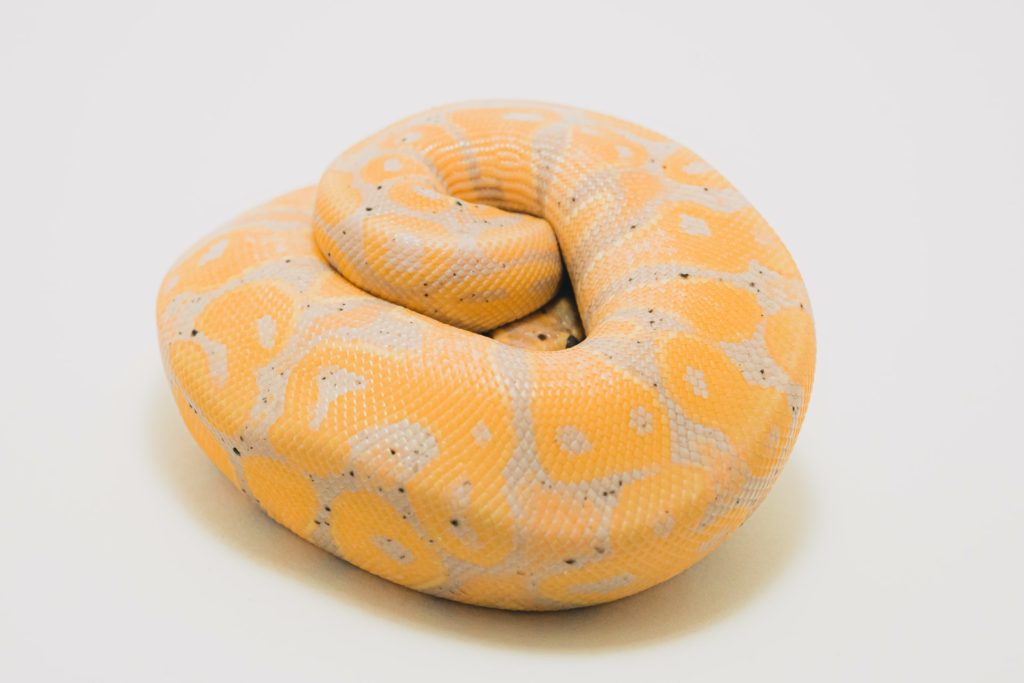
| Average Size (adults) | Up to 182 cm (up to 6.0 ft) |
| Average Weight | 1.5 – 1.6 kg |
| Average Lifespan | 25 – 35 years |
| Diet | Mice and birds |
| Cost | $40-$80 (common morphs) |
Native to West and Central Africa, ball pythons—the smallest of the African pythons—are great pet snakes for beginners.
Behavior
These are very docile and don’t tend to bite. Instead, they tend to curl into a ball when they’re afraid or stressed, with their head safely tucked in the middle (hence their name).
This is their go-to behavior, instead of biting or attacking, which positions them among the best pets for kids.
These are more active during the night and prefer to hide or sleep during the day, so you won’t see it around in its cage very much when the sun is out.
Appearance And Price
These are large snakes that can reach up to 182 cm. Females are slightly larger than males.
They’re naturally dark brown with darker patches all over their bodies, although breeders will have many morphs for you to pick.
The most common morph can be purchased for $40 – $80, but the rarer the morph, the more it will cost.
Some snakes have been sold for 40,000 USD!
Food And Living Requirements
Their care requirements are quite basic, and you can keep it either in a medium-size tank or a rack system.
Make sure you clean their enclosure often and set a shallow bowl of water to give it a place to soak when they’re up to it. This will be especially necessary during the skin shedding process.
You can also spray water daily with a spray bottle for some humidity.
The substrate can be made out of cypress mulch and wood shavings (except cedar, which is dangerous for reptiles), and put in some rocks or a little tree trunk for your pet to hide during the day.
Although they don’t need UV-B bulbs, you should provide an over-the-tank heating lamp or mats on one side of the enclosure, so the snake has “warm” and “cold” areas in there.
These snakes eat small birds and mammals, so mice should be your go-to meal. You can purchase frozen or thawed mice and feed your python once every 7 days or so.
Make sure the food is at room temperature or slightly warmer. Then you can heat it up a bit externally by using a heat lamp or a hairdryer.
Be prepared to face some issues with their eating, for a number of reasons, being the most frequent:
- They’re just not up to it
- They’re about to shed
- The temperature of the enclosure is not comfortable
They can live between 25 and 35 years! Your child will become an adult and still will have their pet to keep them company.
What we love:
- Very low maintenance
- Docile and easy to handle
- No need to provide them supplements or UV-B light
- The common morphs are cheap
- Long lifespan
What gives us pause:
- They can experience eating issues
7. Crested Geckos
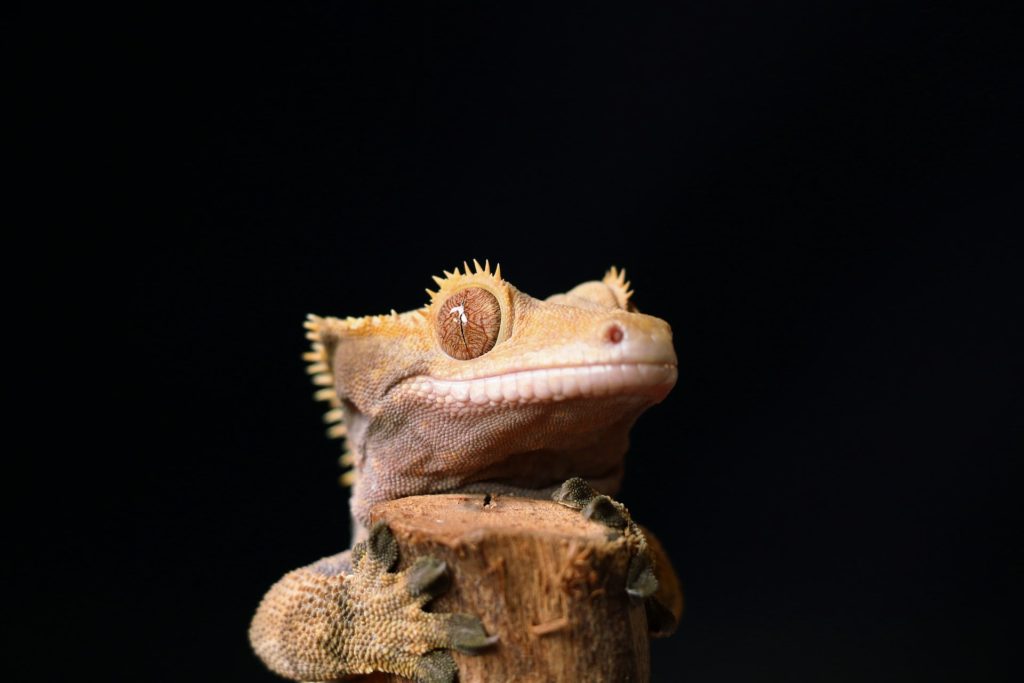
| Average Size (adults) | 10 cm – 25 cm (6 to 10 in) |
| Average Weight | 35 – 55 grams |
| Average Lifespan | 10 – 15 years |
| Diet | Omnivores |
| Cost | $50-$100, up to $5000 the rare morphs |
These interesting animals come from New Caledonia, a Pacific Ocean island close to Australia. They are very low maintenance, and therefore among the best lizard pets for kids.
Behavior
Cresties are extremely docile, and on rare occasions, they might bite, you or your child won’t find it painful. It’ll feel more like a skin pull.
They are more active during the dawn and night and tend to sleep during the day. They are arboreal species (they live in the tree canopy) and love to jump from branch to branch.
Not only that, but they are excellent climbers, too, and in addition to sticky toe pads and tails, their toes have little claws that help them climb different surfaces.
Under stress or danger, they will drop their tails, but unlike other geckos (such as the leopard gecko), crested geckos don’t grow back their tail.
So ask your child to not hold their crestie by the tail!
Appearance And Price
The most significant feature is their “eyelashes” which are two sets of spines that project over the eyes and run over the sides of the head and continue to the base of the tail.
They certainly give the appearance of eyelashes!
You’ll also notice how they clean their eyes with their tongues. O_O
They do this to prevent debris from getting into their eyes since they don’t have eyelids.
In the wild, these animals come in a wide array of colors, being the most commonly brown, gray, red, orange, and yellow.
Of course, breeders will have more morphs, and the general rule applies: the more “unique” the morph, the more it will cost you.
But “average morphs” can cost between $50 and $100.
Food And Living Requirements
Crested geckos are very easy to accommodate, a small terrarium will suffice, but of course, the larger their home, the happier they’ll be.
A medium-sized terrarium with rocks, vines, branches, bromeliads, snake plants or bamboo, will be a dream come true for your pet.
Avoid putting two males crested geckos together!
They are extremely territorial and fights can hurt them badly.
Since geckos are omnivores, you should give them a mix of fruits and insects.
Commercial reptile food, fruits such as mango, passion fruit, banana, papayas, among others, as well as small crickets and wax worms, are perfect options.
You can get your child involved in preparing their crestie’s food!
Feed highly nutritious food to the insects (gut-loading) a day before you give them to your crested gecko.
Dust your pets’ food with vitamin D, calcium, and multivitamin to keep them healthy.
What we love:
- Very docile and cute
- Their home is easy to set up
- Wide arrange of morphs and colors
- They’re omnivores
What gives us pause:
- They are amazing jumpers and climbers, which makes them escape artists
- Their tails don’t grow back if broken
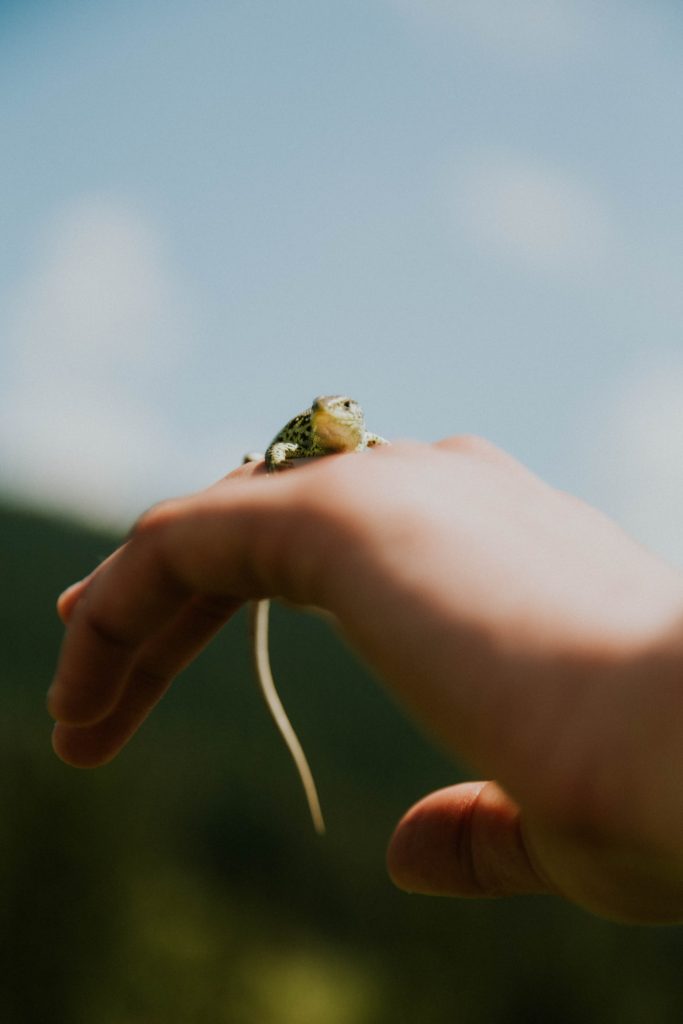
Which Are The Reptiles To Avoid As Pets For Children?
There are many reptile pets for sure, but some of them are just not suitable for kids:
1. Aggressive Reptiles
You won’t want to give your child a pet, only for it to bite and hurt them!
Some lizards, such as iguanas, Tokay geckos, and monitors, can be very aggressive, attacking whatever comes in their way.
So, choose a pet that’s docile enough for your child to safely interact with it.
2. Reptiles With Short Lifespan Or That Needs Special Care
Although every pet requires proper care, there are some of them that simply go above and beyond.
Chameleons, for example, need perfect habitat conditions, or they will die.
And I do mean perfect!
Perfect temperature, ventilation, humidity, enclosure, or they can easily die.
Even stress can kill them. So they’re definitely not child-friendly pets.
3. Venomous Reptiles
This should be obvious, but I’m still stressing it!
Even if a reptile has a small amount of venom that is harmless to an adult human, it still can be very dangerous to children!
So keep them safe, and buy them a venom-free cold-blooded friend.
4. Big Sized Reptiles
Large reptiles are just a no-no.
Especially big snakes such as reticulated pythons, since they can easily crunch a child’s little body with their constriction movements.
In addition to this, big reptiles are expensive to house and feed, so avoid spending thousands of dollars and get a small reptile pet for your family.
Why Choose A Reptile As A Pet For Your Kid?
Now that we left the scary part out of the way, let’s talk about some benefits of having reptile pets for your kiddos!
1. Reptiles Are Low Maintenance Pets
Even if they need proper care and feeding, like any other pet, reptiles are very easy to take care of.
Just clean their enclosure once in a while, ensure they have their heating and UV-A/UV-B bulbs on and at the proper temperature, and feed them with their vitamins and calcium supplements, and you’re done!
It might seem like a lot, but once you and your child get into the routine, you guys are done.
No grooming routines, baths, everyday walks to go to the bathroom, nor chewing on your shoes!
2. They’ll Teach Your Kids Empathy
Keeping a pet is an awesome way to teach your kids to be empathetic towards other beings.
Reptile pets, especially, will help your child to become very observant to pick up changes in their behavior, coloration, etc., as signals of stress or sickness.
Your little one will slowly become less self-focused, as they are usually at younger ages.
3. Reptiles Don’t Take Too Much Space
Even if you have a blue-tongued skink, reptile pets will live in their enclosure most of the time.
Little ones, such as the leopard geckos, will occupy small to medium size terrariums that you can set up in a corner of your home and let them be!
4. Reptiles Are Great For Your Kids’ Responsibility And Self-Esteem
Taking care of a pet requires love, time, and efforts that will help your child to become more responsible.
They will be involved in preparing their pets’ food, filling the water bowl, clean the enclosures, all of which are vital to keeping their cold-blooded friends alive.
Starting to participate in chores like these will help your kid to become more responsible, and because their role as caregivers will be so important, it will boost their confidence and self-esteem.
5. They Help Develop An Interest In Nature
Reptiles are less common pets like dogs and cats, for example. They seem more exotic and interesting.
They provide an excellent opportunity for you to teach your little one about their habitat, food requirements, and cool processes like shedding.
Your child will be more interested in nature and its creatures for sure, which is amazing.
What To Consider Before Picking A Reptile Pet For Kids?
1. Time
Even when they are easy to take care of, reptiles do take attention and time from their owners.
Make sure your kid will have time to take care of their pet and act as proper caregivers.
2. Cost
Of course, your budget will have a say in the whole buying a reptile pet process!
Not only do you need to think about the cost of the animal, but you’ll need to provide a proper enclosure, heating and UV bulbs, and appropriate food.
If your pet is a herbivore, you can feed most of the same vegetables and fruits that your family eats.
But if mice and insects are involved, this will mean extra cash to spend.
3. Lifespan
Many of the pets on this list can potentially live for many years.
If you’re planning to move frequently, remember that you’ll have to take your pet and enclosure around with you, so maybe it will be wiser to pick a pet with a shorter lifespan.
4. Care Level
Some reptiles are very demanding, which can overwhelm a child.
Buy a pet that won’t suffer too much if your kid forgets to feed them once, or that is sturdy enough that they won’t be harmed while your child learns to handle it.
5. Permits
The illegal wildlife trade has been recognized as one of the main causes of biodiversity loss.
Make sure you get your pet from a legit source—in compliance with wildlife trade regulations—and preferably from common, non-threatened species.
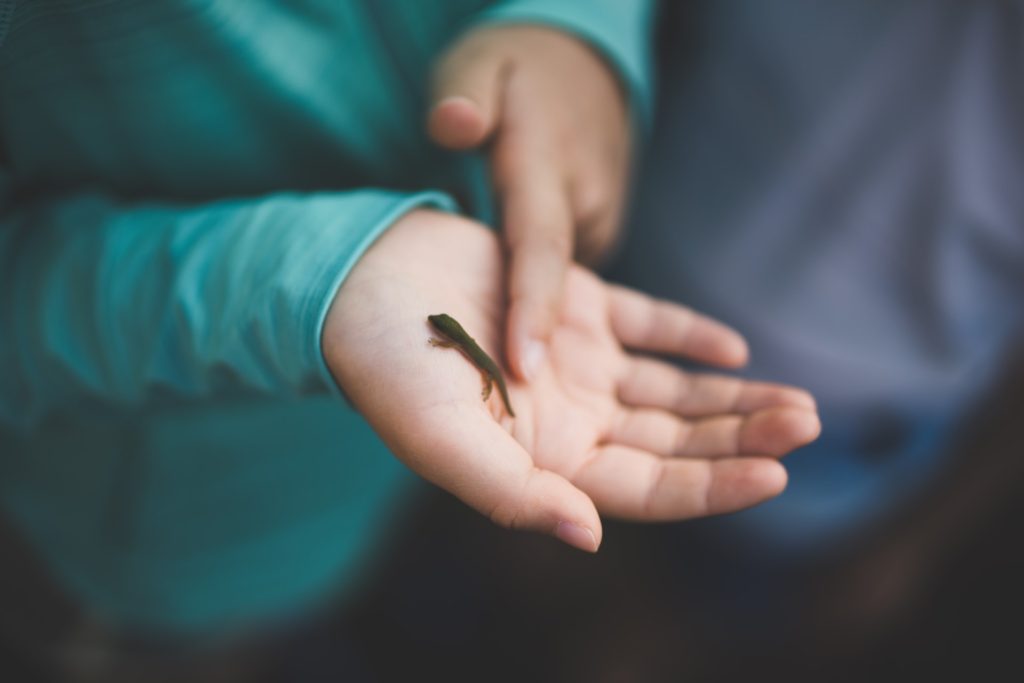
FAQ
What Are The Best Reptile Pets For Kids To Handle?
There are a few, but bearded dragons’ non-aggressive character makes frequently handling them and interacting with them a delight. Their large size and sturdy body earn them a spot among the best reptile pets for handling.
What Is The Best Lizard To Buy For A Child?
Leopard geckos are the best lizards to buy for your child, but beardies are a great option too!
What Are Some Good Reptile Pets For Beginners?
All the reptiles on this list are great reptile pets for someone who has never owned one before. The easy-care level, the docility of their character, and their beautiful appearance make them excellent reptile pets.
Final Thoughts
I hope this list of the best reptile pets for kids has helped you decide which one to buy for your child (or whether to do it).
Reptiles are low-maintenance pets that are fascinating to watch and interact with, and I’m sure your child will become more responsible and confident by owning and taking care of one.
Do you have any other suggestions about good reptile pets for children?
Let us know in the comments below!
A total nerd since the beginnings of my life, I always had a thing for nature and found fascinating all kinds of living beings (yes, even fungus).
Reptiles became my passion and research subject in college, and I love to ramble about them to anyone interested in listening. Oh, I’m also a Copywriter!
Check the About us page to learn more about me. Keep on herping! 🙂

